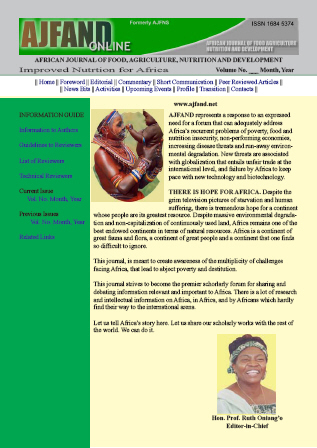
|
African Journal of Food, Agriculture, Nutrition and Development
Rural Outreach Program
ISSN: 1684-5358
EISSN: 1684-5358
Vol. 10, No. 3, 2010, pp. 2258-2271
|
 Bioline Code: nd10027
Bioline Code: nd10027
Full paper language: English
Document type: Research Article
Document available free of charge
|
|
|
African Journal of Food, Agriculture, Nutrition and Development, Vol. 10, No. 3, 2010, pp. 2258-2271
| en |
Climate Change Impacts on Cowpea Productivity in Nigeria
Ajetomobi, J. & Abiodun, A.
Abstract
If a climate signal could be detected at state or regional level, it would be useful to
policy planners, agricultural authority and farmers to prepare for climate change. This
study, therefore, employed a statistical model to investigate the relationship between
the yield of cowpea and temperature (in centigrade) and precipitation (in millimeters)
for the period 1961 – 2006 at state levels in Nigeria. The analyses were based on all
the twenty major cowpea producing states for the main period 1961 -2006. Data for
annual yield of cowpea for all the time period were collected from the Nigeria Bureau
of Statistics (N.B.S). Data on the two important climate variables required for crop
growth - temperature and precipitation - at state in Nigeria were obtained from the
Nigerian Metrological Agency. The response of cowpea yield to climate change
varied from one geographical location to the other. The results indicated negative and
significant relationship between cowpea yield and temperature in six of the twenty
states producing cowpea in the country. Five of the six states are in the northern part
while the remaining one is in the south. The results of the relationship between the
yield and precipitation were similar to those of temperature in the northern states,
except Sokoto. There was a negative correlation between rainfall and cowpea yield in
Adamawa, Bauchi, Kaduna, Katsina, Kwara, Niger Plateau and Yobe. On the
contrary, increase in precipitation will lead to increase in yield in the southern part
except Kwara. The time trend is positive and significant in all the cases except in
Adamawa, Bauchi and Jigawa where time trend was non significant though
positive. These results also show that as the years pass by and climate factors run
contrary to agricultural productivities, cowpea farmers were adopting new measures
to cope with the negative effect of climate change. Through adaptation, the negative
effects of climate change on cowpea yield could be reduced and the positive
influences enhanced. Examples of potential adaptive measures include the
introduction of drought or heat resistant varieties, early sowing, mixed cropping,
alteration of the tillage system and utilization of land that has been considered too
marginal for agricultural cultivation.
Keywords
Climate change, statistical modeling, Nigeria
|
| |
© Copyright 2010 - African Journal of Food Agriculture, Nutrition and Development.
Alternative site location: http://www.ajfand.net/
|
|
